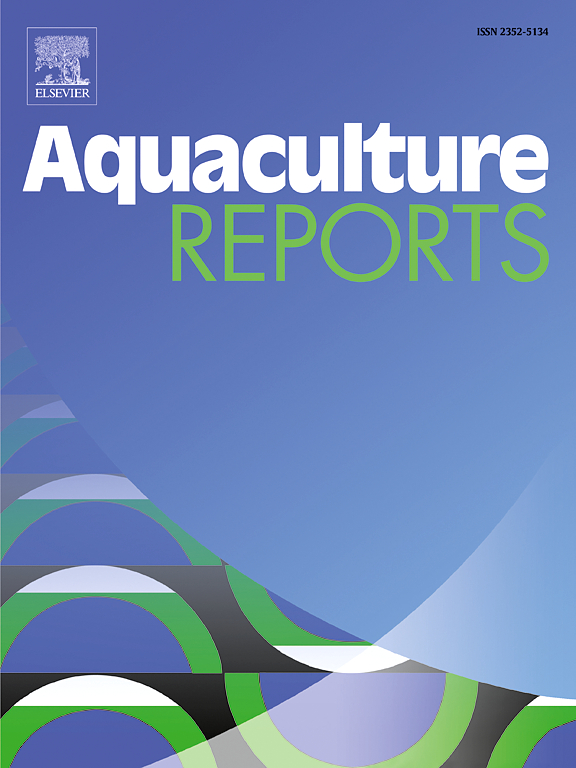Dietary taurine supplementation can improve the growth, protein metabolism, immunity and muscle development of larval largemouth bass (Micropterus salmoides)
IF 3.2
2区 农林科学
Q1 FISHERIES
引用次数: 0
Abstract
This study aimed to explore the impact of dietary taurine supplementation on the growth, amino acid transport, protein metabolism, immunity, and muscle and skeletal development of larval largemouth bass (Micropterus salmoides). The larvae (initial weight: 367.53 ± 0.05 mg) were fed with six graded levels of dietary taurine (0 % (control group), 0.15 %, 0.3 %, 0.6 %, 1.2 %, and 2.4 %) for 21 days, which was sufficient for the duration of feeding trial of fish larvae. Results indicated that the weight gain rate and specific growth rate (SGR) of larvae showed a quadratic increase after dietary taurine supplementation (P < 0.05), reaching a maximum in the 0.3 % group. The protease activity was significantly enhanced by 0.3 % of dietary taurine (P < 0.05). The crude protein and amino acid content in the larvae were increased with taurine supplementation, peaking at 0.3 % (P < 0.05). The average myofiber diameter was also significantly enhanced in the 0.3 % group (P < 0.05). Compared to the control group, the supplementation of 0.3 % dietary taurine could upregulate the expressions of amino acid transport protein genes (P < 0.05). The TOR pathway was triggered by 0.3 % of dietary taurine. The AAR, autophagy-lysosome, ubiquitin-proteasome, and calpain pathways were inhibited by 0.3 % dietary taurine. The expressions of myocyte proliferation-related genes (such as Pax3a, MHC, MyoD) and MyoD protein, and Mstn were significantly increased and decreased by dietary taurine, respectively (P < 0.05). In addition, the mRNA levels of skeletal development-related genes were upregulated. Furthermore, dietary taurine supplementation upregulated anti-inflammatory and anti-apoptotic gene expressions, and reduced pro-inflammatory and apoptotic factor expressions in the liver. In summary, dietary taurine enhanced intestinal protein digestion and amino acid absorption, facilitated muscle protein deposition and myofiber development, and improved immunity and skeletal growth, thereby promoting growth in larval largemouth bass. Regression analysis based on the SGR revealed that the optimal taurine supplementation level was 0.288 %.
饲料中添加牛磺酸可促进大口黑鲈幼鱼的生长、蛋白质代谢、免疫和肌肉发育
本研究旨在探讨膳食中补充牛磺酸对大口鲈鱼(Micropterus salmoides)幼鱼的生长、氨基酸转运、蛋白质代谢、免疫以及肌肉和骨骼发育的影响。给幼鱼(初始体重:367.53 ± 0.05 mg)喂食六种分级水平的牛磺酸(0 %(对照组)、0.15 %、0.3 %、0.6 %、1.2 % 和 2.4 %),持续 21 天,这足以满足鱼类幼鱼喂养试验的持续时间。结果表明,补充牛磺酸后,幼鱼的增重率和特定生长率(SGR)呈二次曲线上升(P < 0.05),在 0.3 % 组达到最大值。日粮中添加 0.3 % 的牛磺酸可显著提高蛋白酶活性(P < 0.05)。补充牛磺酸后,幼虫体内的粗蛋白和氨基酸含量增加,0.3 % 组达到最高(P < 0.05)。0.3 %组的平均肌纤维直径也明显增加(P < 0.05)。与对照组相比,补充 0.3 % 的膳食牛磺酸可上调氨基酸转运蛋白基因的表达(P < 0.05)。0.3 %的膳食牛磺酸触发了TOR通路。0.3%的膳食牛磺酸可抑制AAR、自噬-溶酶体、泛素-蛋白酶体和钙蛋白酶通路。膳食牛磺酸分别显著增加和减少了肌细胞增殖相关基因(如 Pax3a、MHC、MyoD)和 MyoD 蛋白以及 Mstn 的表达(P < 0.05)。此外,骨骼发育相关基因的 mRNA 水平也上调。此外,膳食补充牛磺酸还能上调肝脏中抗炎和抗凋亡基因的表达,并降低促炎和促凋亡因子的表达。总之,膳食牛磺酸能促进肠道蛋白质消化和氨基酸吸收,促进肌肉蛋白质沉积和肌纤维发育,改善免疫力和骨骼生长,从而促进大口鲈鱼的生长。基于 SGR 的回归分析表明,牛磺酸的最佳补充水平为 0.288%。
本文章由计算机程序翻译,如有差异,请以英文原文为准。
求助全文
约1分钟内获得全文
求助全文
来源期刊

Aquaculture Reports
Agricultural and Biological Sciences-Animal Science and Zoology
CiteScore
5.90
自引率
8.10%
发文量
469
审稿时长
77 days
期刊介绍:
Aquaculture Reports will publish original research papers and reviews documenting outstanding science with a regional context and focus, answering the need for high quality information on novel species, systems and regions in emerging areas of aquaculture research and development, such as integrated multi-trophic aquaculture, urban aquaculture, ornamental, unfed aquaculture, offshore aquaculture and others. Papers having industry research as priority and encompassing product development research or current industry practice are encouraged.
 求助内容:
求助内容: 应助结果提醒方式:
应助结果提醒方式:


